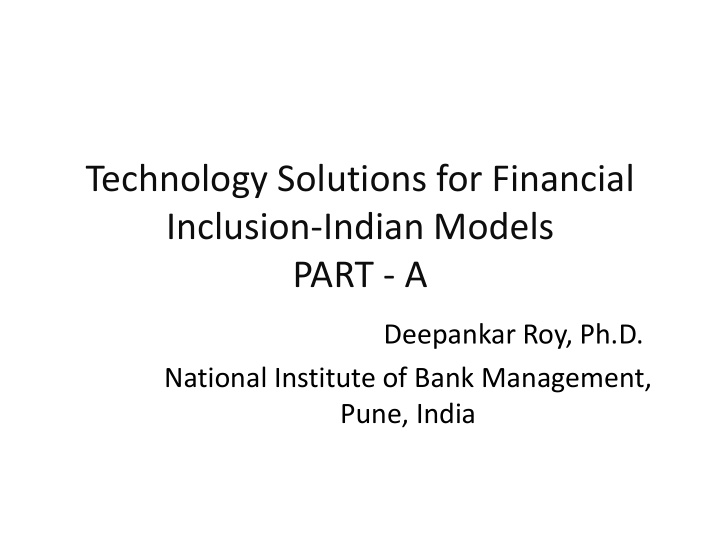



Technology Solutions for Financial Inclusion-Indian Models PART - A Deepankar Roy, Ph.D. National Institute of Bank Management, Pune, India
Information and Communication Technology (ICT) • Financial Inclusion, without the intensive use of ICT in the Indian context appears almost impossible • Of a total of 6,38,596 villages in the country, 4,94,442 (or 83.3%) have less than 2,000 inhabitants with a total population of 340 million as per 2001 census. • Covering all these villages with brick and mortar branches of banks would be nearly impossible • The estimated cost of a cash transaction - a deposit or withdrawal - across the counter might be on an average Rs. 50, an ATM transaction Rs. 15, a transaction using a mobile Re. 1 and through the internet a fraction of a Rupee • With the extensive use of technology, Banking Correspondents(BCs) have the potential to reduce the cost of transactions and position themselves between the mobile and the ATM
Electronic Transfer of Social Benefits • ICT could be used for electronic transfer of social benefits through the bank accounts of the beneficiaries and deliver government benefits at the doorstep • In the initial years of evolution of the BC model, all transactions used to be routed through the server of the technology provider and the settlement used to take place at the end of the day or within 24 hours. • Lately some banks have evolved own technology solutions allowing BCs to use their own Financial Inclusion server connected to the core banking server at the back-end. • For instance, in the case of Punjab National Bank in India, Infosys has provided the financial inclusion solution in their regular core banking solution.
The Two Models • The BCs are found to use two models viz, 1) The Smart Card Based Kiosk Model and 2) The Mobile Hand set based Model. • Under the mobile based model there are two types viz; one where a GPRS based mobile is used to access the server through the internet and the other through Short Messaging Service (SMS) or Unstructured Supplementary Service Data (USSD) technology .
1) The Smart Card Based Kiosk Model • Under this model, each customer is given a smart card with a 32k/64k memory chip where the following details are stored:primary account number, postal address, nominee details, contact information and transaction history. • Both the CSP and the customer are issued smart cards. • The CSP’s smart card is used for authenticating the Point of Sale (POS) machine, establishing connection with the intermediate server for BOD (Begin of Day), EOD (End of Day), data transfer and to prevent the misuse of the POS machine. • The customer is authenticated using the biometric finger print stored in the smart card.
1) The Smart Card Based Kiosk Model • The CSP get connected using any secured communication channel such as Global System for Mobile communications (GSM), Code Division Multiple Accesses (CDMA), Public Switched Telephone Network (PSTN) or Ethernet depending upon the type of connectivity available at the local place of operation. • Through this connectivity, the CSP reaches the backend intermediate Financial Inclusion server belonging to service provider/bank. • All customer details and account information including current balance is held by the FI server which will regularly update the bank’s core banking server at pre-decided intervals or on a real time basis.
1) The Smart Card Based Kiosk Model • The Kiosk has the potential to carry out about 150 transactions per day. • The command area of the kiosk is one village or at times one or two nearby villages. • CSP is supervised by the BC Network Manager (BCNM) who deploys a supervisor for 5-10 CSPs. • An exclusive deposit account is maintained by the CSP in the base branch which is debited or credited each time a transaction is undertaken by the CSP. • The CSP also maintains a physical cash balance, usually Rs10,000/-. At the end of each day, the CSP remits the excess cash holding above the overnight standard cash limit to the base branch or withdraws sufficient money to maintain the cash limit
2) The Mobile Hand set based Model a) GPRS based mobile model • In this model, the CSP uses a high end General Packet Radio Service (GPRS) based, Near Field Communication (NFC) mobile phone with a camera in place of a PC. • It will have wired or blue-tooth serial connection to a hand held printer, bar code reader, contact or contact less smart card reader etc. • The mobile phone with the CSP will have sufficient memory to carry data on all customers including their photographs and finger prints. • The transactions can be carried out both on line and off line. • Advantage: No need for biometric card
2) The Mobile Hand set based Model b) Mobile for banking transactions • This is the cheapest model available where the CSP and the customer can use any mobile hand set to put through a cash debit or credit transaction. • The system is not dependent on the mobile network operator, or handset model or operating system on the handset. • The client interface is just dialing of numbers. It works using Short Messaging Service (SMS) or unstructured supplementary service data (USSD) technology
2) The Mobile Hand set based Model b) Mobile for banking transactions • Under the model, a person with a mobile phone can open a no frill account with the CSP. • The customers types the bank’s short code, then an asterisk, then the mobile number of the person they are paying, then an asterisk, then the amount, followed by another asterisk and the customer code. • This model has been successful in metropolitan cities as a means of remittance by the migrant workers. • The advantage of the model is its low cost
Recommend
More recommend